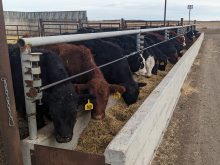HOWEVER the Jan. 23 election turns out, this campaign has marked the end of the short-lived Agricultural Policy Framework as the permanent template for farm policy planning.
Just a few years ago, then-agriculture minister Lyle Vanclief and his deputy Samy Watson, with the sometimes-unenthusiastic compliance of provinces, proclaimed the APF as the future.
This campaign put the final nails in the coffin of the founding principles of the APF.
On the sidelines, farm leaders must be mouthing: “I told you so.” From the beginning, farmers complained that the APF, with its business risk management offspring, was illegitimate, the creation of bureaucrats and politicians without practical farm input.
Read Also

Topsy-turvy precipitation this year challenges crop predictions
Rainfall can vary dramatically over a short distance. Precipitation maps can’t catch all the deviations, but they do provide a broad perspective.
The result has been one of the most unpopular and ineffective farm programs in a generation, despite the record amounts of support governments say it generated.
The money was sent too late, often to farmers least in need of help while farmers with three and four years of bad market luck received little or nothing.
Former New Democratic Party agriculture critic Dick Proctor once quipped that the APF predecessor, AIDA, “put the ‘duh’ into aid.” The Canadian Agricultural Income Stabilization program, based on the same rearview mirror view of farm need, has been no more successful.
But clearly, CAIS as it was conceived is about to end. That message was telegraphed during the election campaign.
The Conservatives were the most clear. “A Conservative government will work with the provinces to replace the CAIS program in order to make income stabilization more responsive for average producers,” said its platform.
The New Democratic Party condemned CAIS as inadequate and ill advised.
Before we get to Liberal proposals, all framed around the presumption that CAIS will be “reviewed” and “redesigned” in 2006, it is useful to remember the core principles of the APF agreed to in Whitehorse and finally approved by enough provinces two years later to implement.
Vanclief and his provincial supporters agreed that the new template meant no ad hoc payments beyond CAIS, a 60-40 federal-provincial costing split and a complicated payment formula based on five-year margin averages with the highest and lowest years removed.
Payments would be made after the fact, based on historic profit margins. Across the country, one size would fit all. Provincially designed and federally supported companion programs would not exist.
Trade rules would require that payments not be made on a commodity specific or production basis. Whole farm was the new mantra and there could be no attempt to match American subsidies.
Lately, the Liberals have been improvising policies that effectively negate those founding principles. They have announced a series of ad hoc payments during the past two years. So much for that APF principle.
They have promised in the campaign that regionally sensitive add-on programs will be developed that pay out more quickly, giving Canadian farmers the same tools as Americans. So much for the end of companion programs and the APF rearview mirror approach.
They have said ad hoc payments will no longer count against CAIS income calculations. So much for CAIS as the central program.
Effectively, CAIS and APF as designed by the political class and their bureaucratic managers are dead. The next government will have to move on.
Shed no tears.














